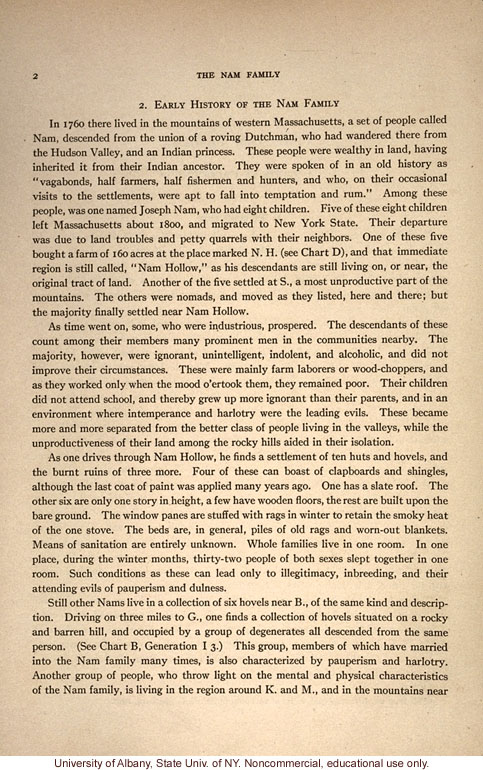2 The Nam Family
2. Early History of the Nam Family
In 1760 there lived in the mountains of western Massachusetts, a set of people called Nam, descended from the union of a roving Dutchman, who had wandered there from the Hudson valley, and an Indian princess. These people were wealthy in land, having inherited it from their Indian ancestor. They were spoken of in an old history as "vagabonds, half farmers, half fishermen and hunters, and who, on their occasional visits to the settlements, were apt to fall into temptation and rum." Among these people, was one named Joseph Nam, who had eight children. Five of these eight children left Massachusetts about 1800, and migrated to New York State. Their departure was due to land troubles and petty quarrels with their neighbors. One of these five bought a farm of 160 acres at the place marked N. H. (see Chart D), and that immediate region is still called, "Nam Hollow," as his descendants are still living on, or near, the original tract of land. Another of the five settled at S., a most unproductive part of the mountains. The others were nomads, and moved as they listed, here and there; but the majority finally settled near Nam Hollow.
As time went on, some, who were industrious, prospered. The descendants of these count among their members many prominent men in the communities nearby. The majority, however, were ignorant, unintelligent, indolent, and alcoholic, and did not improve their circumstances. These were mainly farm laborers or wood-choppers, and as they worked only when the mood o'ertook them, they remained poor. Their children did not attend school, and thereby grew up more ignorant than their parents, and in an environment where intemperance and harlotry were the leading evils. These became more and more separated from the better class of people living in the valleys, while the unproductiveness of their land among the rocky hills aided in their isolation.
As one drives through Nam Hollow, he finds a settlement of ten huts and hovels, and the burnt ruins of three more. Four of these can boast of clapboards and shingles, although the last coat of paint was applied many years ago. One has a slate roof. The other six are only one story in height, a few have wooden floors, the rest are built upon the bare ground. The window panes are stuffed with rags in winter to retain the smoky heat of the one stove. The beds are, in general, piles of old rags and worn-out blankets. Means of sanitation are entirely unknown. Whole families live in one room. In one place, during the winter months, thirty-two people of both sexes slept together in one room. Such conditions as these can only lead to illegitimacy, inbreeding, and their attending evils of pauperism and dullness[sic].
Still other Nams live in a collection of six hovels near B., of the same kind and description. Driving on three miles to G., one finds a collection of hovels situated on a rocky and barren hill, and occupied by a group of degenerates all descended from the same person (See Chart B, Generation I 3.) This group, members of which have married into the Nam family many times, is also characterized by pauperism and harlotry. Another group of people, who throw light on the mental and physical characteristics of the Nam Family, is living in the region around K. and M., and in the mountains near
[end]


